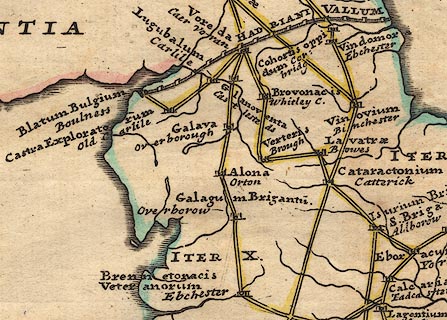




 click to enlarge
click to enlargeStu1Cm.jpg
item:- Hampshire Museums : FA2001.171
Image © see bottom of page
placename:-
"The Roman highway, which I have so often mentioned, and which, in my last letter, I left at Leeming Lane and Peers Brigg, in the North Riding of York, enters this county from Rear Cross upon Stanmore, and crossing it almost due east and west, goes through Appleby, passing the Eden a little north from Perith, at an antient Roman station call'd Brovoniacum,"
"..."
"Here [Carlisle] also the great Roman highway, ... has its end, this being the utmost station of the Roman soldiers on this side."
 goto source
goto sourcePennant's Tour 1773, page 138 "I traversed Sandford-heath, over which runs the Roman road, which is continued through the county from Brougham ..."
 goto source
goto sourcePage 151:- "The great Roman road passed through this county from Stanemore to Brougham castle, and till the turnpike road was made it was very conspicuous almost the whole length of its course, six yards broad, formed of three courses of large square stones, (the lowermost largest) or of gravel and flint as materials varied. ..."
placename:- Maiden Way
 goto source
goto sourcePage 159:- "..."
"The Roman road called the Maiden way passes through a large camp, where the stone of king Marius formerly stood, now succeeded by the Rere cross. Thence through Maiden castle, a small square fort, in which have been found Roman mortars, quite through Market Brough, over Brough fair hill, ... Leaving on the left Warcop, a pretty village ... it passes along Sandford moor, and down a horse course to Cowpland beck bridge, where on the right are the ruined foundations of a noble round tower 40 paces diameter, ... Then by Appleby to the camp on Crackenthorp moor, through the end of Kirkby Thore downs, and through Temple Sowerby, a village of the Dalstons of Acorn bank. Then by the side of Whinfield forest to Hart-horn tree, ..."
 goto source
goto sourcePage 160:- "..."
"... From hence the road goes due west to the Countess pillar, ..."
"From hence the road carries us to Brougham castle, to Lowther bridge, and so over Emot into Cumberland."
